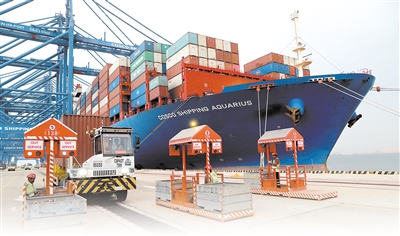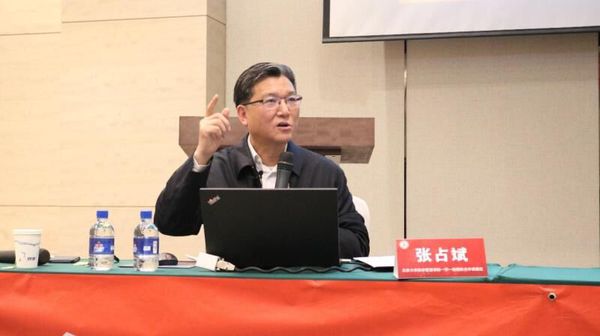Wang Yongzhong: The Development Path Of Economic And Trade Cooperation In The Joint Construction Of The "Belt And Road" Under The Current Global Political And Economic Structure
Wang Yongzhong: The Development Path Of Economic And Trade Cooperation In The Joint Construction Of The "Belt And Road" Under The Current Global Political And Economic Structure
Wang Yongzhong, Director and Researcher of the International Commodity Research Office of the Institute of World Economics and Politics, Chinese Academy of Social Sciences, click here to view the complete video click here to view the video album click here to view the courseware editor's note: "Belt and Road" is an important initiative in international economic and trade cooperation.
Wang Yongzhong Director and Researcher of International Commodity Research Office of the Institute of World Economics and Politics, Chinese Academy of Social Sciences
Click here to view the full video
Click here to view the video album
Click here to view the courseware
Editor's note: As an important initiative in international economic and trade cooperation, the "Belt and Road" has been deeply rooted in the hearts of people of all countries over the past decade and has actively promoted mutually beneficial and win-win international relations. This article focuses on the complex and changeable background of the current global political and economic situation. Based on the analysis of the global political and economic situation, it deeply explains China's current economic status and prospects, and systematically interprets how the "Belt and Road" initiative strengthens economic and trade cooperation with countries and provides new growth points for my country's economic development. The article fully demonstrates the various development directions and goals of the Belt and Road Initiative, as well as its implementation results in multiple fields such as cooperation, trade and facility connectivity, and strongly demonstrates the important role of this initiative in international economic and trade exchanges. This research is of great significance for exploring China's new path of foreign economic and trade cooperation and helps promote the diversified development of international economic cooperation.
1. Analysis and prospects of global political and economic situation
(I) Global political situation
1. China-US relations
Under the current international situation, the competitiveness of China-US relations has increased. The deep-seated reasons behind this are China's development and the gradual narrowing of the gap in strength between China and the United States. Before the global financial crisis broke out in 2008, China-US economic relations showed a high degree of complementarity. The United States focuses on the development of high-tech, services and high-end manufacturing, while China focuses on labor-intensive industries. This division of labor model allows China to provide the United States with a large number of cheap and high-quality labor-intensive products. At the same time, China further strengthened the economic ties between the two countries, and the United States also imported a large number of high-quality and low-priced commodities from my country, which to a certain extent reduced the inflation level in the United States. Therefore, a mutually beneficial and win-win economic relationship has been formed between China and the United States.
Since 2008, the competition between China and the United States has become increasingly prominent, and the fundamental reason lies in the significant similarity in the strength of the two countries. Through studying hard, China continues to extend along the industrial chain, gradually climbing from labor-intensive industries to high-tech industries, especially in 5G, new energy and other fields, it has achieved achievements that are parallel to or even surpassing the United States. At the same time, in the field of manufacturing, China has developed into a world factory with a complete global industrial chain, forming a huge team of engineers and rich labor resources. These factors have made China form a relative advantage over the United States in the manufacturing field, and have become the basic factors for the strengthening of Sino-US competition.
At present, Sino-US relations show a new feature called "comprehensive competition", which involves a wide range of political, economic, military and other fields. Therefore, in the face of the United States taking advantage of its dominance in the market and global political and economic fields, it has created relatively unfavorable international relations for China.
During the Biden period, Biden implemented the "small Yard, High Fence" policy for China, namely "Small Yard, High Fence", including key high-tech industries such as chips, artificial intelligence, and biomedicine into the "small Yard", and built a high wall, gradually promoting the decoupling of China-US technology, and implementing supply cutoffs and investment-banning related fields to China. In addition, the Biden administration has joined hands with its allies to implement policies such as near-sea outsourcing, friendly sea outsourcing and manufacturing return to the local area. At the same time, the United States also proposed ABC (but China), which is anything except China; there is also "China-plus-one", called "China plus one", weakening China's core position in the global industrial chain. These strategies have joined forces with some countries and have had a significant negative impact on China's external environment.
During Trump's second term, Sino-US relations face greater challenges. On April 2, 2025, since Trump announced the "Liberation Day Action", American society has experienced "three blows" - the stock market fell sharply, the bond market fell sharply, and the foreign exchange market fell sharply. Because US Treasury bonds are the safest asset in the world, they usually attract a large amount of funds during financial or economic crises, causing Treasury bond prices to rise and interest rates to fall. Judging from the impact of the US dollar, when the global financial crisis breaks out, generally speaking, the global market often experiences capital flows from developing countries to developed countries such as the United States. However, the current situation is different. The Trump administration has taken a series of aggressive actions against the market rules, which has led to a significant decline in global investors' confidence in the US economy. This change has also challenged the attractiveness of the US Treasury market, resulting in capital outflow from the United States, falling US Treasury bonds, rising interest rates and depreciation of the US dollar, which has shaken the basis of US global hegemony, especially financial hegemony. Therefore, the Trump administration had to take concessions to suspend some tariffs on other countries, especially excessive tariffs, and appropriately relax controls during the Geneva and London talks. At the same time, the United States lifted export restrictions on China's chip design software (EDA).
2. China-Europe relations
At present, the competition in China-EU relations is mainly reflected in the economic field. Although the Trump administration's tariff policies on Europe and its criticism of Europe have led to a deepening rift between the United States and Europe, it also provides room for improving China-Europe relations. Under the current circumstances, both China and Europe believe that strengthening dialogue and cooperation is very important. In May 2025, after agreement between the two sides, China and the European Parliament decided to lift restrictions on mutual exchanges simultaneously and completely. As China and Europe fully resume legislative exchanges, the exchanges and understanding between the two sides will be deeper, which will inject new impetus into the sustained, healthy and stable development of China-EU relations.
3. China-Russia relations
At present, China and Russia will rely on in-depth cooperation in energy, finance and other fields to jointly respond to the challenges faced in the international political and economic fields.
4. China’s relations with neighboring countries
As an important economic and trade partner of China, ASEAN has close economic and trade ties and a solid foundation for cooperation. There are many Chinese in Southeast Asian countries such as Malaysia, which provides a natural bond for bilateral exchanges and cooperation. China has always adhered to a pragmatic attitude, promoted the in-depth development of cooperation and built a diversified and balanced cooperation pattern.
Central Asia is a key hub connecting Europe with the Land Silk Road Economic Belt during the construction of the "Belt and Road". Since the China-Central Asia Summit achieved institutionalization, the political mutual trust between the two sides has continued to deepen and economic and trade cooperation has accelerated. As important oil and gas resource countries, Kazakhstan, Turkmenistan and other countries have maintained friendly and cooperative relations with China for a long time and have made positive contributions to regional energy security and economic development.
Brazil is an important global commodity supplier, exporting large quantities of oil, soybeans, iron ore and other resources to my country. In 2024, China's soybean imports exceeded 100 million tons, of which 74.6473 million tons of soybeans were imported from Brazil. Therefore, Brazil has become my country's most important economic and trade partner in South America.
Regarding the analysis of the future global geopolitical situation, overall, the importance of Sino-US relations as the dominant force in shaping the future global geopolitical pattern is self-evident. However, the policy uncertainty of the Trump administration has also had a profound impact on the global political landscape, and this uncertainty has intensified to a certain extent. To this end, the "Belt and Road" initiative proposed by our country came into being under such a general background. Looking back, my country's foreign trade and trade are mainly concentrated in developed countries, both in export markets and foreign direct investment (FDI), and are closely related to developed countries. With the continuous upgrading of my country's industries, the competitiveness with developed countries is increasing. This phenomenon is not only reflected in the competition between China and the United States, but also in the tension in China-EU economic and trade relations. These all deeply reveal the reality of political and economic interest games and competition. Therefore, the "Belt and Road" initiative proposed by our country can provide an important buffer space for our country.
(II) Global economic situation
In the context of the global economy, U.S. policies have had far-reaching negative impacts on the global economy. Since the outbreak of the new crown pneumonia epidemic, the overall growth rate of the global economy has slowed down, which is not unrelated to the rise of deglobalization and trade and investment protectionism. The Trump administration's "reciprocal tariffs" policy imposed not only on its allies and major trading partners, but also on poor developing countries, has had a serious negative impact on the global economy.
1. The transformation of China's economy
China has contributed more than 30% to world economic growth for many years. In recent years, with the transformation and upgrading of China's economy, my country's economy is undergoing a transformation from investment-driven to consumption-driven, and China's economy is looking for new growth points. But for the United States, we must realize that the problem of US Treasury bonds, especially its debt scale, and fluctuations in the US dollar exchange rate may have greater volatility in the US financial market and even the global economy.
Overall, the global economy is facing a difficult period at present. The Trump administration's tariff policy in the United States makes it difficult to realize the expectation of a return of US manufacturing industry in the short term. Faced with this situation, my country must actively explore new momentum and enhance the driving effect of consumption on economic growth, but it will also take a certain amount of time, so the future growth rate of the global economy has slowed down significantly.
2. Geopolitical risks rise
Given the current complex situation of Sino-US competition, geopolitical risks are showing an upward trend. Generally speaking, rising geopolitical risks will cause the US dollar to appreciate. However, the US dollar is not performing strongly at present, especially the sharp rise in US debt, and the independence of the US dollar is declining. Therefore, global status and confidence in the US dollar have been shaken. This phenomenon is directly reflected in the sharp rise in gold prices. From a global perspective, gold prices are mainly pegged to the US dollar and are denominated in US dollars. The strength of gold prices is mainly driven by investors' doubts about the US economy, the US financial system and the US dollar's status, as well as geopolitical factors.
3. De-globalization
On a global scale, the trend of anti-globalization is becoming increasingly significant. Since the outbreak of the financial crisis in 2008, although global trade volume has not declined sharply and has remained relatively stable overall, cross-border investment, including foreign direct investment (FDI) and overseas direct investment (0DI), has experienced a cliff-like decline. Since the assets involved in investment are relatively fixed, the trade chain is relatively short and the trading method is more direct, the impact of investment is much greater than that of trade. At the same time, the global energy transformation problem is becoming increasingly prominent, especially the Trump administration has completely abandoned international obligations in global climate action. If the world continues to follow the current development model, the rise in the earth's temperature, increase in greenhouse gas emissions, and intensified climate change in the future will cause huge damage to the earth's environment.
Against the backdrop of uncertainty in the current global political and economic situation, we must realize that the competition among major powers is becoming increasingly fierce. In the face of a series of challenges, we should actively respond to it to achieve sustainable development and common prosperity.
2. The current status and prospects of China's economy
First of all, in accordance with the overall deployment of my country's "14th Five-Year Plan", 2025 is an important year of finale. During the 14th Five-Year Plan period, we simultaneously looked forward to the long-term goals for 2035, namely, nine specific goals in terms of "basically achieving socialist modernization by 2035", and "my country's economic strength, scientific and technological strength, and comprehensive national strength will rise significantly."
Secondly, we examine China's manufacturing industry from a global perspective and emphasize its unique position in China's economic system. As a solid foundation for China's economic development, manufacturing industry demonstrates the integrity of China's industrial chain, the comprehensiveness of industrial supporting facilities, and the hugeness of the team of engineers and architects. Its advantages constitute an important support for China in global economic competition.
Finally, from the comparison of the global centrality of China and the United States in multiple industrial fields, China's professionalism in electrical, optical equipment, metal smelting, transportation manufacturing, and construction industries surpasses that of the United States. China has made remarkable achievements in high-end fields such as Industry 4.0, artificial intelligence, big data, Internet of Things, 5G and 3D printing, and is expected to achieve leapfrog development against the United States.
3. The implementation results of the Belt and Road Initiative
(I) Revitalize the stock and be cautious in the incremental volume
In the initial stage of the Belt and Road Initiative, we focused on promoting a series of significant infrastructure projects undertaken mainly by state-owned enterprises, because the smooth implementation of the initiative requires solid infrastructure as support.
Entering a new era, we have optimized and adjusted the implementation of the "Belt and Road" initiative. In the past, we focused on iconic large projects, but now we need to improve the quality of existing projects, improve the operation level of existing projects, and strictly evaluate the feasibility of incremental projects. This implementation adjustment reflects our high attention to project quality and firm pursuit of sustainable development. In short, we are committed to optimizing and upgrading existing assets and precisely checking incremental projects.
(II) "Large freehand painting" turns to "fine brushwork, small and beautiful"
From "freehand brushwork" to "fine brushwork", the "Belt and Road" initiative has become a popular new platform for global public products and international cooperation in the world today, injecting new impetus and opening up new space for the prosperity and development of the world economy. Its international appeal, influence and cohesion have been continuously enhanced. Iconic projects are important, but they should be combined with small and beautiful projects to complement each other. For example, although photovoltaics and other people's livelihood projects are small, they can quickly benefit the people of the "Belt and Road" country, allowing them to obtain tangible benefits as soon as possible and experience the efficient results of the projects. Overall, "fine brushwork, small but beautiful" is the direction of in-depth implementation and development of the "Belt and Road" initiative.
(III) Energy Transformation
Under the framework of the "Belt and Road" initiative, China has always adhered to energy transformation and achieved the "dual carbon" goal, and actively advocated green development. On the premise of ensuring fiscal sustainability and fully considering the fiscal affordability of participating countries, China is committed to promoting green energy. Especially in Africa where the power grid infrastructure is weak, distributed energy systems, such as photovoltaic power generation, have become an effective way to solve energy poverty. Photovoltaic power generation does not need to rely on large power grids, and it has become an efficient choice thanks to Africa's lower development costs and vast land resources. Laying photovoltaic panels not only helps solve local energy shortages, but also conforms to the general trend of global energy transformation. However, for geopolitical considerations, Western countries have set high trade barriers for China's photovoltaic industry. In my country, the production capacity of the photovoltaic industry has reached a considerable scale, and land resources in the eastern and central regions are relatively tight. However, in the western regions such as Xinjiang, despite the continuous photovoltaic panels, there is still a vast space for photovoltaic facilities layout.
However, the photovoltaic industry also has certain limitations, mainly manifested in the instability of power generation. For example, the effective time of photovoltaic power generation in a year may be only more than one thousand hours. The volatility of its power supply coupled with the limited power sales capacity in some areas and the inability to absorb it on site has created the demand for power transmission through ultra-high voltage technology. At the same time, the volatility of power supply also poses a challenge to the stable operation of the power grid, and a large number of energy storage facilities are required to calm down the fluctuations, which will undoubtedly increase the cost of power grid construction. Under the current technical conditions, the development of a photovoltaic application model with distributed rather than centralized large power grids may be more suitable for African countries with relatively stable power supply and shortage of power.
(IV) Foreign investment
The proposal of the "Belt and Road" initiative marks the deepening and expansion of China's opening-up strategy. More than ten years ago, when this initiative was first proposed, China's foreign direct investment and foreign investment were mainly concentrated in developed countries. At the same time, my country's foreign investment mainly relies on foreign exchange reserves, especially investing in US Treasury bonds with relatively low yields. Therefore, at the internal level, we emphasize more on reducing China's dependence on developed countries through the "Belt and Road" initiative, and thus strengthening the economic and trade ties with developing countries.
(V) Areas of cooperation
First, the Belt and Road Initiative has shown significant advantages in the field of resources. The country it jointly built generally has rich mineral resources and energy resources, which not only provides strong support for China's sustainable development, but also promotes in-depth cooperation with China in the fields of industry and production capacity.
Secondly, the current scope of cooperation in jointly building the "Belt and Road" has been expanded to more than 150 countries and more than 30 international organizations on five continents around the world, becoming the world's largest, most extensive and most influential international economic cooperation platform. The signing of these cooperation agreements fully reflects my country's firm determination to open up to the outside world and its positive attitude towards international cooperation, and has contributed to the promotion of the building of a community with a shared future for mankind.
Thirdly, the trade volume of goods between my country and the countries jointly built by the "Belt and Road" continues to grow steadily. From 2018 to 2023, China's trade in goods between the countries jointly built by the "Belt and Road" increased from US$1.9 trillion to US$2.8 trillion, with an average annual growth of 8.1%, and the proportion increased from 40.6% to 46.6%. In 2024, my country's total imports and exports to countries jointly built the "Belt and Road" were 22.07 trillion yuan, an increase of 6.4%, accounting for more than 50% of my country's total import and export value. This achievement fully demonstrates my country's positive trend of opening up to the outside world and demonstrates the strong vitality and broad prospects of the "Belt and Road" initiative.
Finally, with the in-depth development of a new round of scientific and technological revolution and industrial transformation, the process of digitalization, greening and intelligentization of the world economy is constantly accelerating. Against the backdrop of rapid changes in information technology and leading new changes in social production, the digital economy has become an important part of the global economy, and green development has become a consensus among countries around the world today. The joint construction of the "Belt and Road" has adapted to the general laws and trends of the times in the world's economic, technological, industrial and social development. There is still a lot of room for strengthening cooperation and cultivating new growth points in new fields such as digital and green. In addition, my country actively promotes capacity cooperation in new energy, especially the widespread use of photovoltaic products and technologies, effectively helping to jointly build the development of clean energy in the country, and has contributed to solving the problem of energy poverty.





